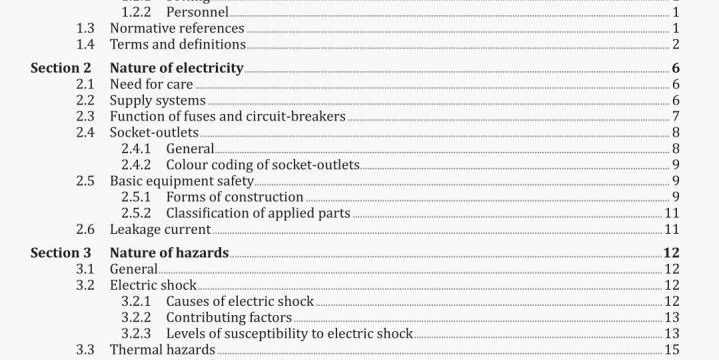Safe use of medical electrical equipment
AS NZS 2500-2020 pdf download.Safe use of medical electrical equipment in health care.
Radiant energy may also cause other hazards such as dehydration. These effects may be significant when infants are treated with infant warmers and with phototherapy units.
Microwave energy can heat the body and can cause damage to the lens of the eye. Doses above recommended levels can cause tissue damage.
The eyes and the gonads are particularly susceptible to microwave-induced injury.
There is also evidence that low-level, long-term exposure can induce effects on the nervous, haemopoietic, and immune systems of small animals. These effects cannot he adequately explained in terms of purely thermal mechanisms and the mechanism of injury is not yet understood.
In New Zealand, specifications of the levels to which the operators of the equipment and others in the vicinity may be exposed are given in AS/NZS 2772.1. In Australia. guidance is given by ARPANSA through the Radiation Protection Standard for Maximum Exposure Levels to Radiofrequency Fields—3 kHz to 300 GHz. These documents do not specify maximum levels of electromagnetic fields to which patients may be exposed for medical purposes by appropriately qualified persons. Nevertheless, due to the incomplete understanding of some of the biological effects of radiofrequency radiation, every effort should be made to keep exposure to such radiation as low as Is reasonably achievable.
3.4.2 UltrasonIc energy
The safe level of ultrasonic energy varies depending on the site of application. Temperature rises, particularly at tissue interfaces such as the tissue bone interface, have been observed.
Some studies indicate that high levels of ultrasound output can cause hearing impairment.
3.4.3 Laser and intense light sources
Many lasers are capable of inflicting biological damage. For most laser wavelengths, this damage occurs principally through the heat generated by the interaction of light with matter. Ultraviolet light generated by lasers will interact directly with organic molecules to cause cell damage in addition to the heat mechanism of damage. Very high-power lasers may also produce a thermally induced shock wave that may damage tissue some distance from the site of beam exposure.
In addition to the hazards of exposure to a direct laser beam, exposure to its reflections caused by smooth reflecting surfaces, such as mirrors, lenses and untreated surgical instruments, is often hazardous depending upon the amount of electromagnetic energy reflected. Diffuse reflections may also be hazardous when the reflected electromagnetic energy is sufficiently intense.
High-power lasers and Intense light sources that are capable of inflicting eye or skin damage are normally classified Class 3B and Class 4. High-power lasers and intense light sources are regulated by Australian federal legislation and some states and territories. Legislation may specify the premises at which such a device may be used and may contain provision for use by licensed operators only.
Stray magnetic fields or incidental electromagnetic energy may interfere with equipment. Such interference may result in a danger to the patient by modification of function or through incorrect measurements. The source of such fields may be the power supply mains (at 50 Hz) or other equipment. For example, electrosurgical or high frequency therapy equipment, when in use, may interfere with the function of nearby equipment, including computers and cardiac pacemakers.
Electromagnetic interference can be caused by a variety of sources. Examples of typical sources of electromagnetic interference include:
(a) Real-time location systems (RTLS)/ Radio Frequency Identification (RFID) systems.
(b) Mobile communications equipment (i.e. phones, tablets).
(c) Radio-transmitters (hand-held, vehicle-fitted or base stations).
(d) Other medical electrical equipment (electrosurgery or diathermy units, telemetry systems).
A responsible organization should have policies regarding the introduction and use of RF transmitting devices. This policy may include the requirement for an assessment to be completed to determine adequate separation distances between medical devices, which have an individual immunity, and the emitting device.
3.6 Electrostatic hazards
The accumulation of electrostatic charge on personnel or equipment may result in a spark discharge. It may cause an unpleasant but innocuous shock to personnel or the patient. However, the spark may be of sufficient energy to ignite a combustible material. Examples of combustible materials include alcohol skin preparations and cloth drapes. This risk is increased in the presence of high oxygen concentrations.
Relative humidity above 55 % and antistatic conductive materials will reduce spark discharges.
Even when the electrostatic shock is of a low energy level, it may still cause unanticipated reaction and movement which in turn may present a hazard to attending clinical personnel or the patient or both.
3.7 Loss of electrical power
A hazard can be created by the failure of the electrical power supply to critical areas where medical electrical equipment Is used. This is normally addressed within the hospital setting by a combination of locally generated and battery-fed UPS capabilities. In clinical areas where patient care may be interrupted by loss of power to the facility, the responsible organization should make an informed choice of normal, essential or UPS power sources taking into account the run time of equipment on its own internal battery supply, should it be so equipped. Locally generator-fed essential supplies still have a short (typically 20—30 s) interruption before power is restored. Socket-outlets that are supplied from a UPS have no loss of supply if the normal supply falls. Power outlets are colour coded as white (normal supply), red (essential) and blue (UPS-backup supplied) respectively to assist in managing this issue.AS NZS 2500-2020 pdf download.
Safe use of medical electrical equipment
